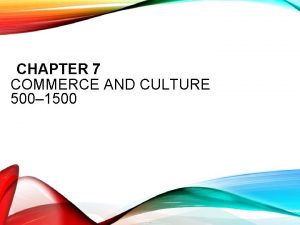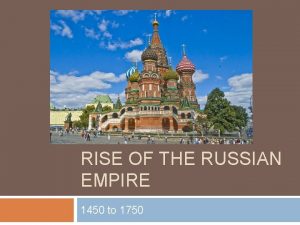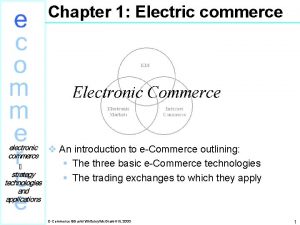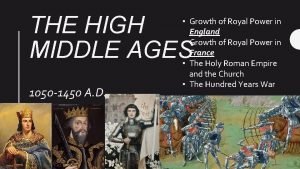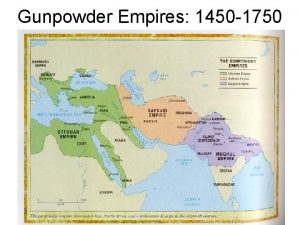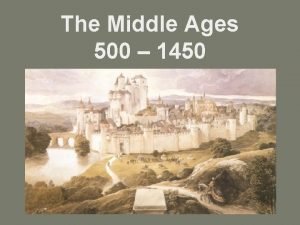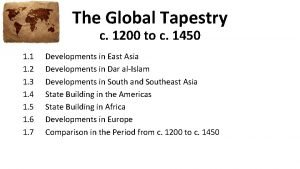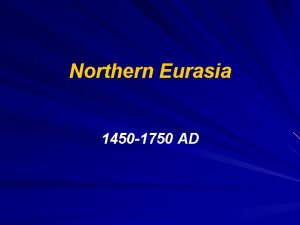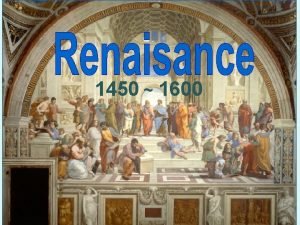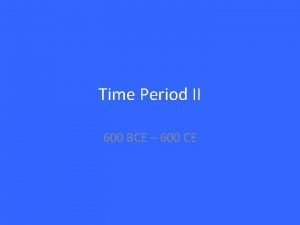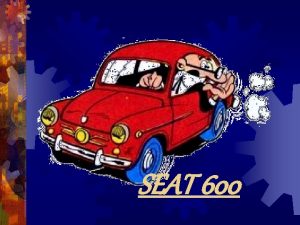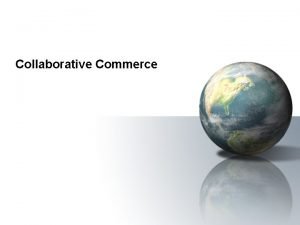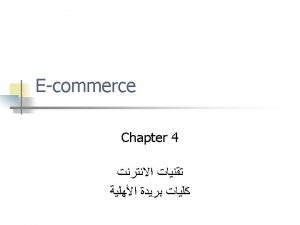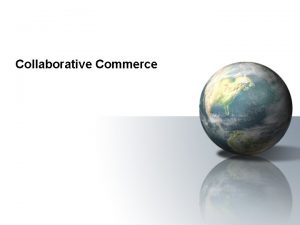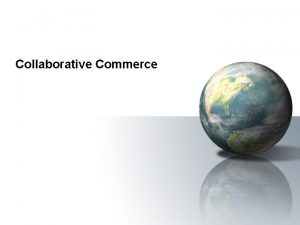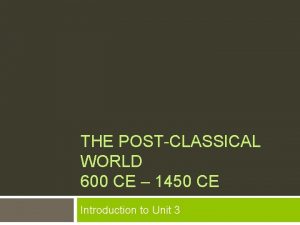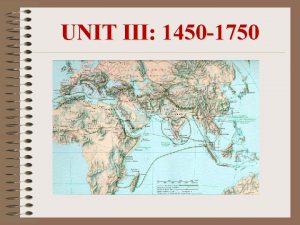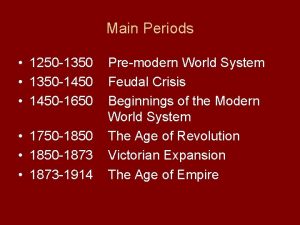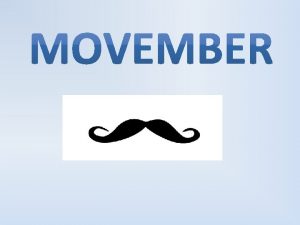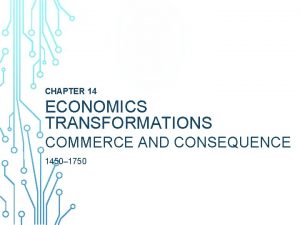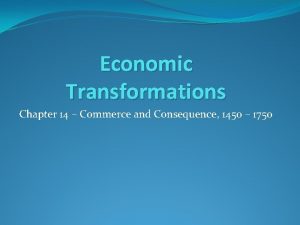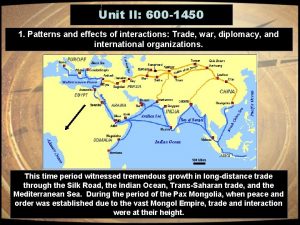Commerce and Culture Chapter 7 600 1450 Introduction


























- Slides: 26

Commerce and Culture Chapter 7 – 600 – 1450

Introduction �Long-distance trade became more important than ever between 600– 1450, linking and shaping distant peoples and societies. �Most trade was indirect; separate transactions. �Creation of a network of communication and exchange across the Afro-Eurasian world; separate web in parts of the Americas.

Significance of Trade �It altered consumption and shaped daily life. �It encouraged specialization in production. �Diminished economic self-sufficiency of local societies. �Merchants often became a distinct social group. �In some societies, a means of social mobility. �It provided prestigious goods for elites. �The wealth from trade motivated state creation in various parts of the world. �Religious ideas, technological innovations, plants and animals, and disease also spread along trade routes.

Map of the Silk Roads

The Growth of the Silk Roads �Outer Eurasia: relatively warm, well-watered (China, India, Middle East, and the Mediterranean). �Inner Eurasia: harsher, drier climate, much of it pastoral (eastern Russia and Central Asia). �Steppe products were exchanged for agricultural products and manufactured goods. �The creation of classical civilizations and imperial states included efforts to control nomadic pastoral peoples. �By the early centuries of the Common Era, there was a network of transcontinental exchange, often brokered by pastoral peoples.

Goods in Transit �Transport by camel – very expensive; small volume. �Generally luxury goods, for example, silk from China. �At first China had monopoly on silk, eventually silkworms brought to Europe. �Drain of resources on Europe. �Silk was used as currency, in Central Asia, and considered a symbol of high status.

Cultures in Transit �Cultural transmission was more important than exchange of goods. �Buddhism spread along the Silk Roads. �Monasteries, along silk roads, provided rest stops for merchants, and many converted. �Mahayana Buddhism flourished and spread to China.

Mahayana Buddhism

Disease in Transit �Long-distance trade meant exposure to unfamiliar diseases. �During the Roman and Han Empires, smallpox and measles devastated both populations, facilitating political collapse. �Between 534 and 750 C. E. , the bubonic plague from India ravaged the Mediterranean world. �This made it harder for Christendom to resist Muslim armies from Arabia in the 7 th century C. E. �The Black Death spread thanks to the Mongol Empire’s unification of much of Eurasia in the 13 th and 14 th centuries. �Europeans gained an advantage when they confronted peoples in the Western Hemisphere after 1500.

The Black Death

Sea Roads: Exchange across the Indian Ocean �Mediterranean and Black Seas and Atlantic coast – city-state of Venice was center of trade by 1000 C. E. -Much wealth came from control of most trade from Asia, from the Red Sea through Alexandria. �Indian Ocean – the most important and largest trade routes before 1500. -Cheaper, safer, and bulk goods on ships (compared to luxury goods on camels). �Monsoons – seasonal winds that made trade possible.

Weaving the Web of an Indian Ocean World �Began with the First Civilizations: -Indus Valley writing may have been stimulated by cuneiform. �While there was local maritime trade in the Indian Ocean in the first millennium B. C. E. , Malay sailors began to make long-distance travels across the ocean. They brought various crops as far as East Africa. There are still various cultural traces of these Malay voyagers in Africa. �Fulcrum of trade was India: -spread of Hinduism and Buddhism in Southeast Asia.

Weaving the Web of an Indian Ocean World �China: -Chinese products flooded the Indian trade network. -China (Tang and Song Dynasties) developed larger ships and the magnetic compass. -China provided a vast market for Indian and Southeast Asian goods. �Islam: -Muhammad was a trader (friendly to trade). -widespread conversion to Islam made trade easier. -Arab Empire stretched from Atlantic Ocean to India.

Map of the Sea Roads

Sea Roads as a Catalyst for Change: Southeast Asia �Srivijaya (670– 1075): Sumatra-based kingdom owed its power to the control over the flow of trade through the Straits of Malacca. Collected supplies of gold, spices, and taxes from ships passing through this crucial choke point in trade between the Indian Ocean and East Asia. �Khmer kingdom of Angkor (800– 1300): this state had a strong agricultural base but also traded forest products with Chinese and Indian merchants. �Borobudur and Angkor Wat: the first is a massive Buddhist monument in Java. Angkor Wat is one of many Khmer monuments, a Hindu temple. �“Indianization: ” strong economic, religious, and cultural influences from India. Southeast Asian cultures blended these imports with their own ideas, traditions, and practices.

Map of Southeast Asia (ca. 1200 C. E. )

Borobudur

Sea Roads as Catalyst for Change: East Africa �Swahili civilization of East Africa (8 th century C. E. ) developed from blend of Bantu with commercial life of the Indian Ocean (especially Islamic). �Growing demand for East African products: gold, ivory, quartz, leopard skins, some slaves, iron, and wood products. �Swahili civilization flourished on East African coast between 1000 and 1500 C. E.

Sea Roads as Catalyst for Change: East Africa �The Swahili culture was urban and composed of independent city-states. There was no political unity. �Cultural fusions: Swahili cities were home to a rich fusion of various cultures from Africa, the Middle East, and Asia. �Muslim Africans: the East Coast of Africa became home to a large population of Muslims. Thus, felt they had more in common with Arabs and Persians than animist Africans. �Great Zimbabwe: Swahili merchants forged links with peoples of the interior of the continent as well as further south. The kingdom of Great Zimbabwe had much wealth and social organization.

Map of East Africa

Sand Roads: Commercial Beginnings of West Africa �Sand roads refer to trade across the Sahara. �Environmental variation around the Sahara: to the north goods such as weapons, tools, books, clothes, and glassware. The Sahara had deposits of copper and salt as well as oases with date palms. To south, there were millet and sorghum farmers. In the forests, root and tree crops such as yam and kola nuts grew. �Sudanic West African trade and urban centers: there were a number of urban centers along the Niger River that were key hubs of trade.

Gold, Salt, and Slaves: Trade and Empire in West Africa �West Africa traded gold, salt, and slaves. �In return, peoples of the Sudan received horses, cloth, dates, manufactured goods, and salt. �Huge caravans (as many as 5, 000 camels). �Creation of a series of states in western and central Sudan between 500 and 1600 C. E. , including Ghana, Mali, and Songhay. These were wealthy monarchies. �Slave trading: slaves were generally taken from stateless societies further to the south. Slaves were also exported to the Islamic slave markets of the north.

Map of the Sand Roads

An American Network �There was no sustained interaction between the Western and Eastern hemispheres before the voyages of Columbus. �Limitations: -lack of domesticated large mammals, wheeled vehicles, and large oceangoing ships. -geographical or environmental obstacles. �There was a major trade network in Mesoamerica. The Mayan and the Aztecs made themselves wealthy by controlling the trade routes through their territory. Much of the trade was in luxury goods. In the Aztec realm, there were professional merchants called “pochteca. ” �The Inca used their 20, 000 -mile road system to run a statecontrolled trade network of various commodities from the diverse lands they controlled.

Map of the American Trade Web

Reflections: Economic Globalization – Ancient and Modern � Luxury goods of the ancient world: Because of transportation costs, relatively light luxury goods dominated the ancient economic networks. � Mass consumption in the modern world: In the industrialized modern world, humans could ship commodities for mass consumption. � Multi-polar ancient economy: The ancient world had a relatively balanced system with no dominant center. � Western dominance in the modern economy: In the modern era, Western Europe came to dominate the global system.
 Apwh period 3
Apwh period 3 Commerce and culture chapter 7
Commerce and culture chapter 7 Nilai dari sin 600 + tg 600 adalah
Nilai dari sin 600 + tg 600 adalah Location-based commerce (l-commerce)
Location-based commerce (l-commerce) Saq answer example
Saq answer example Russian empire religion 1450 to 1750
Russian empire religion 1450 to 1750 Examples of popular culture
Examples of popular culture Continuous culture and batch culture
Continuous culture and batch culture Indian vs american culture
Indian vs american culture Uses of selenite f broth
Uses of selenite f broth Folk culture and popular culture venn diagram
Folk culture and popular culture venn diagram How does popular culture diffuse
How does popular culture diffuse Stab culture and stroke culture
Stab culture and stroke culture Folk culture and popular culture venn diagram
Folk culture and popular culture venn diagram Stroke culture method
Stroke culture method Carpet culture method
Carpet culture method Surface culture deep culture and esol
Surface culture deep culture and esol What is e commerce introduction and definition
What is e commerce introduction and definition Introduction of commerce and business exercise
Introduction of commerce and business exercise Mughal empire 1450 to 1750
Mughal empire 1450 to 1750 1450 ad
1450 ad Best buy st george utah
Best buy st george utah Fur trade ap world history
Fur trade ap world history Land based empires 1450 to 1750
Land based empires 1450 to 1750 500/1450
500/1450 Global tapestry
Global tapestry Japan 1450-1750
Japan 1450-1750

